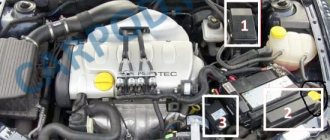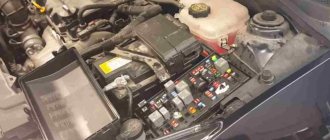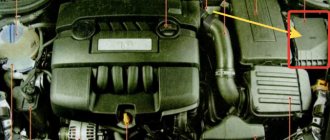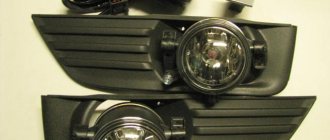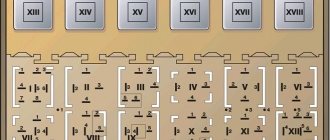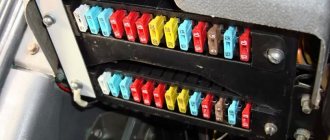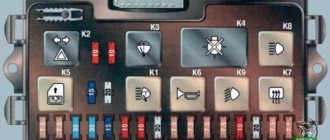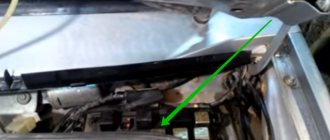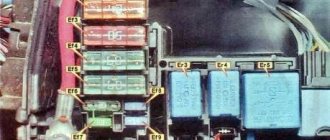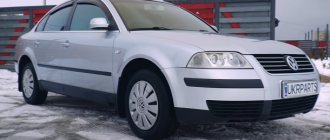The new generation of Audi 80 b3 was introduced in mid-1986. Produced in 1987, 1988, 1989, 1990 and 1991. They were sold worldwide under the Audi 80 or Audi 90 brands (denoting higher-spec cars). The most common nickname in the CIS is “Bochka”. In our material you can find a detailed description of the relays and fuses on the Audi 80 90 b3 and their locations.
The tables provided are universal. On certain Audi 80 and Audi 90 models, some components or individual systems may be missing. It is also possible that the specified fuses and ratings may partially differ from the fuses installed on your machine. Refer to your description on the back of the protective cover.
General arrangement of electronic control units in the cabin
- On-board computer/unit for automatic diagnostics of vehicle systems;
- Electronic fuel injection control unit or Motronic electronic control unit;
- Electronic air conditioning control unit;
- Vehicle position (height) sensor above sea level;
- Electronic ignition control unit;
- Buzzer for switching off automatic transmission mode;
- Air conditioner control panel;
- Power seat power relay.
- Electronic control unit for electric seats;
- Additional mounting block;
- Airbag activation unit;
- Airbag;
- Electronic control unit for automatic transmission;
- Hazard warning light (turn signal) breaker;
- Diagnostic system contact connectors;
- Contact connector for fog lights.
The Audi 80 b3 has two main relay and fuse blocks. One is under the hood, near the wipers. The second one is under the dashboard in the cabin.
Where is the Audi 80 B4 Starter Relay located?
Where is the starter relay?
On vehicles with a manual transmission there is no such relay. in the 2nd building under the driver's torpedo. state.
The idle speed fluctuates. When you press the gas, the speed drops and the car doesn't move, tell me what you like better.
Have a nice day, wash and adjust the gas
Hi all. 1988 Audi 100 with RT engine. Explain the probable cause. On a cool morning, in other words, on a hot day (temp. around 90 degrees), the car starts perfectly. Unfortunately, if, for example, you stand for 2-3 hours and, so to speak, warm up, it will not start right away. It starts the same way as after a 5-7 second rotation of the starter or after the 2nd test (but then immediately). If you then turn off the engine, it will reboot normally. Diagnostics not available. I live in the Kaliningrad region. Thank you.
Hello, without diagnostics it will be bad, since there are many circumstances, most likely the dispenser is clogged and the lambda probe does not even work
Sorry wrong) two. not AVK, but AVT. same question, thanks
Marking sensor 053 919 501 A Injection system sensor This cannot be misleading.
You answered me that on my engine it happens that the valve bends when the timing belt breaks, how can I understand the answer that this happens and bends, please explain
Good afternoon, looking at how quickly the belt broke
What shock absorbers should I put on this model? Gas, oil or petroleum? Who were your relatives? How much do they cost? Definitely back and front.
Did you forget to indicate the engine marking and for what reason?
the car is moving, then no. it feels like there is at most a liter under the hood
Hello, what is the engine size?
Relay mounting block in the cabin
Decoding for cars produced before 1989
| Relay No. in the picture above | Name |
| 1 | ABS relay |
| 2 | Seat belt warning relay |
| 3 | Interior lighting relay |
| 4 | A/C clutch relay |
| 5 | |
| 6 | Headlight relay |
| 7 | — |
| 8 | — |
| 9 | — |
| 10 | — |
| 11 | — |
| 12 | Reverse current relay (electric seats and rear view mirrors) |
| 13 | Front passenger seat heater relay |
| 14 | Driver Seat Heater Relay |
| 15 16 | Relay for electric sunroof and power windows |
| 17 | — |
| 18 | — |
Decoding for cars produced after 1989
| Relay No. in the picture above | Name |
| 1 | ABS relay |
| 2 | Seat belt warning relay |
| 3 | Interior lighting relay |
| 4 | A/C clutch relay |
| 5 | Windshield wiper/washer relay* |
| 6 | Headlight relay |
| 7 | |
| 8 | — |
| 9 | Automatic Shift Lock Relay |
| 10 | — |
| 11 | — |
| 12 | — |
| 13 | Front passenger seat heater relay |
| 14 | Driver Seat Heater Relay |
| 15 16 | Relay for electric sunroof and window lifts |
| 17 | Anti-theft warning light relay |
| 18 | Reverse current relay (electric seats and rear view mirrors) |
Central fuse distribution panel
This unit is located in the rear of the engine compartment.
On the removed cover (7) of the central switch, a short form (6) shows the possible location of the relays and fuses. There are also small plastic pliers for disconnecting fuses. Inside the central switch, various relays (1), diagnostic plugs (2), fuses 1–21 (3), and additional fuses 23–32 (4) are visible. Next are four spare fuses (5).
Scheme
Table for Audi 80, 90 models up to 1989
| № | Elements of the protected circuit |
| 1 | 15A Fog lamps for headlights and rear lights |
| 2 | 15A Hazard Light Interrupter |
| 3 | 25A Horn, brake light |
| 4 | 15A Interior lamps, luggage compartment lamp, Audi 80 90 cigarette lighter fuse, sun visor mirror lamp, on-board computer, radio |
| 5 | 30A Engine Cooling Fan |
| 6 | 5A Lamps for side and parking lights of the right rear lamp |
| 7 | 5A Side light and parking light lamps of the left rear light |
| 8 | 10A Main beam lamp of the right headlight, control lamp for turning on the main beam headlights |
| 9 | 10A Left headlight high beam lamp |
| 10 | 10A Low beam lamp, right headlight |
| 11 | 10A Low beam lamp for left headlight |
| 12 | 15A Instrument cluster, reverse lamps, on-board computer, self-diagnosis system unit, Electronic control unit for the anti-lock brake system, Electronic differential lock control unit |
| 13 | 15A Fuel pump. |
| 14 | 5A License plate, engine compartment and glove box lamps, instrument cluster lamps |
| 15 | 25A Windshield wiper motor, engine cooling fan, electronic air conditioning control unit, turn signal lamps |
| 16 | 30A Heated rear window, heated rear view mirrors |
| 17 | 30A Electric motor of the fan (supercharger) of the interior ventilation system |
| 18 | 5A Electric rear view mirrors |
| 19 | 10A Central locking |
| 20 | 30A Switch (first stage) engine cooling fan, Electronic fan control unit when the engine is running |
| 21 | 25A Rear cigarette lighter |
| 22 | — |
| 23 | 30A Motors for adjusting the driver's seat position, driver's seat position memory unit |
| 24 | 10A Electronic control unit for the KE-Jetronic or Motronic system |
| 25 | 30A Seat heaters |
| 26 | — |
| 27 | — |
| 28 | 15A Electronic control unit for Motronic system |
| 29 | 5A Reserve |
Relay table
| Number | Name |
| I | Fog light relay |
| II | Engine cooling fan relay |
| (high speed) | |
| III | Cooling fan relay |
| engine when the engine is not running | |
| IV | — |
| V | Unloading relay |
| VI | Air conditioner relay |
| VII | Horn relay |
| VIII | Automatic transmission relay |
| IX | Windshield wiper and washer intermittent relay |
List for Audi 80, 90 models from 1989
1. Fog lights, rear fog lights 15 2. Hazard warning lights 15 3. Horn, heated seats 30 4. Clock, trunk light, vanity mirror, reading light, socket/cigarette lighter, trip computer, full automatic air conditioning, radio, auto-check system (Auto-Check-System) 15 5. Second stage cooling fan speed 30 6. Right tail light, front side light 5 7. Left rear side light, front side light 5 8. Right high beam, high beam indicator lights 10 9. Left high beam headlight 10 10. Right low beam, right headlight leveling motor 10 11. Left low beam, left left headlight leveling motor 10 12. Instrument cluster, reversing light, Auto-Check system -System), automatic transmission, differential lock, on-board computer, control system, speed control, interior lighting lamp with off delay, electronic thermal switch, operation of the cooling system fan after stopping the engine 15 13. Fuel pump 15 14. License plate lamp, lighting instruments, engine compartment lighting, glove compartment lighting, automatic air conditioning 5 15. Turn indicators, windshield wipers, windshield washer pump, heated windshield washer nozzles, cooling system fan (control unit for turning on the cooling fan after stopping the engine), air conditioning 25 16 Heated rear window, heated external rear view mirrors 30 17. Fan, automatic air conditioning 30 18. Electrically adjusted external rear view mirrors, rear window washer (station wagon) 5 15 19. Central locking system, heated door paint mechanism cylinders, alarm 10 20. First stage of the cooling system fan, turning on the fan after stopping the engine 30 21. Self-diagnosis / connecting a diagnostic tool 10 22. Free -
The electric beet lifts, electric sunroof and electric seat adjustment are equipped with automatic fuses that automatically switch on again after the fault has been corrected.
23. Free - 24. Free - 25. Lambda probe heating 5 26. Trailer socket 30 27. Ignition/injection system 10 28. Ignition/injection system 10 29. Brake light 10 30. 31. Cruise control combined with automatic transmission, ABS, differential lock 5 15 32. Ignition/injection system 10
Relay list
- Fog light relay;
- Spare;
- Cooling fan relay;
- Headlight washer relay;
- Unloading relay;
- Engine cooling fan relay;
- Horn relay;
- Automatic transmission relay;
- Relay for intermittent operation of the windshield wiper and washer;
- Fuel pump relay;
- Engine cooling fan relay.
Resistor
A failed heater resistor is a fairly common problem among Audi 80 car owners.
At the same time, fixing such a breakdown yourself is not so difficult. There is no need to go to a car service center and pay someone money for a relatively basic repair. You just need a new resistor, as well as an understanding of the location of the desired object.
It is not difficult to determine that the heater on an Audi 80 does not work precisely because of a resistor failure. A clear sign of such a malfunction is the heater turning on exclusively at speed 4, while fan blowing modes 1, 2 and 3 do not turn on.
Yes, first of all it is recommended to check the condition of the contacts in the control unit, as well as the integrity of the wires. It cannot be ruled out that they are the problem. But if the check did not show any problems in the electrical circuit, then the problem is in the heater resistance resistor. It periodically burns out and therefore needs to be replaced.
If we talk about the location, you will find the resistor directly on the electric motor of the stove. To access it you will need to open the glove compartment and remove it from the rails. In fact, getting to the resistor is extremely easy if you know how to remove the glove compartment.
You need to disconnect the connector with the wires and remove the resistor from the latches. The resistor fails due to the thermal fuse blowing. It needs to be replaced to restore the functionality of the element.
It's up to the motorist to decide, but Audi 80 owners usually use 2 methods:
- buy a new resistor and install it in place of the old one;
- restore the old resistance resistor through makeshift repairs.
Objectively, the best solution would be to purchase a new element that has a quality guarantee from the manufacturer. But this option is more financially expensive. And since it is important for many to save money, it is worth describing the option of repairing and restoring the resistor.
- Here you can take a piece of wire. But the option is not the best. It is preferable to use a simple 10 Amp fuse;
- Using wire cutters, the old fuse is bitten off, and a new 10-amp element is screwed in its place;
- Using copper wires in a protective sheath, as well as electrical tape, the contacts of the resistor are connected to the contacts of the fuse;
- Next, the assembly is assembled in the reverse order;
- The performance of the heater is checked at all speeds.
The experience of motorists shows that such a repair scheme for the heater resistance resistor on Audi 80 cars has every right to exist. But if in doubt, just buy a new resistor and change it according to the instructions. This is literally 10 minutes of your time.
Although fuses, relays and resistors are small parts of a car, they can play a key role in many issues. Including the performance of the heating system on Audi 80 cars in different bodies.
Moreover, checking the condition of the components considered is quite simple. The automaker has provided convenient access to the fuse box and resistor. Even the heater control unit is not as difficult to disassemble as some might think. A few latches and mounting screws separate you from it.
